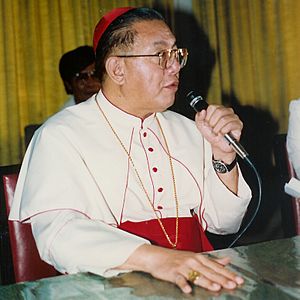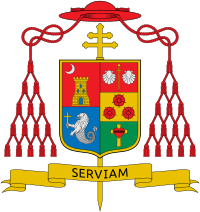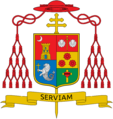Jaime Sin facts for kids
Quick facts for kids His Eminence Jaime Sin CCLH, GCS, GCrL, gcYC |
|
|---|---|
| Cardinal Archbishop of Manila | |

Sin in 1988
|
|
| Province | Manila (Emeritus) |
| See | Archdiocese of Manila (Emeritus) |
| Enthroned | March 19, 1974 |
| Reign ended | September 15, 2003 |
| Predecessor | Rufino Santos |
| Successor | Gaudencio Rosales |
| Other posts | Cardinal-Priest of Santa Maria ai Monti |
| Orders | |
| Ordination | April 3, 1954 |
| Consecration | March 18, 1967 by Antonio Frondosa |
| Created Cardinal | May 24, 1976 |
| Rank | Cardinal-priest |
| Personal details | |
| Birth name | Jaime Lachica Sin |
| Born | August 31, 1928 New Washington, Aklan, Philippine Islands |
| Died | June 21, 2005 (aged 76) San Juan, Metro Manila, Philippines |
| Buried | Crypt, Manila Cathedral |
| Nationality | Filipino |
| Denomination | Roman Catholic |
| Parents | Juan Sin (father) Máxima Lachica (mother) |
| Previous post | Auxiliary Bishop of Jaro and Titular Bishop of Obba (1967–1972) Archbishop of Jaro and Titular Bishop of Massa Lubrense (1972–1974) |
| Alma mater | St. Vincent Ferrer Seminary |
| Motto | Serviam "I will serve" |
| Signature |  |
| Coat of arms |  |
| Styles of Jaime Lachica Sin |
|
|---|---|
 |
|
| Reference style | His Eminence |
| Spoken style | Your Eminence |
| Informal style | Cardinal |
| See | Manila |
Jaime Lachica Sin (August 31, 1928 – June 21, 2005) was a very important leader in the Roman Catholic Church in the Philippines. He was known formally as Jaime Cardinal Sin. He served as the 30th Archbishop of Manila and was the third Filipino to become a Cardinal.
Cardinal Sin played a huge role in two peaceful revolutions in the Philippines. These events changed the country's history. He helped end the strict rule of Ferdinand Marcos in 1986. This event is known as the People Power Revolution. He also helped remove President Joseph Estrada from power in 2001 during the 2001 EDSA Revolution.
Contents
Early Life and Family
Jaime Sin was born on August 31, 1928. His birthplace was New Washington, Aklan, on the island of Panay. His father, Juan Sin, was a merchant of Chinese background. His mother, Máxima Lachica, was from the Aklanon group.
Jaime was the 14th of 16 children. He was a thin child who often had asthma. His family called him "Jim." He was his mother's favorite.
Becoming a Priest
Starting His Priesthood Journey
Jaime left his home to study at St. Vincent Ferrer Seminary. He became a priest for the Archdiocese of Jaro on April 3, 1954. He was the first leader, or rector, of St. Pius X Seminary in Roxas City. He served there from 1957 to 1967. In 1960, he was given the special title of Monsignor.
Becoming a Bishop
On February 10, 1967, he was named an auxiliary bishop of Jaro. This means he helped the main bishop. He officially became a bishop on March 18, 1967.
Leading the Archdiocese of Jaro
On March 15, 1972, Sin became the Coadjutor Archbishop of Jaro. This role meant he would take over the archdiocese later. On October 8, 1972, he was appointed the main Archbishop of Jaro.
Archbishop of Manila
Jaime Sin was chosen to be the Archbishop of Manila on January 21, 1974. At first, he was not sure about taking on this big role. He was officially installed at Manila Cathedral on March 19, 1974. He was only the third Filipino to hold this important position.
On May 24, 1976, Pope Paul VI made him a Cardinal Priest. This is a very high rank in the Catholic Church. As a cardinal, he could vote for a new Pope. He voted in the elections that chose Pope John Paul I and Pope John Paul II in 1978. He was the youngest cardinal until 1983.
Cardinal Sin's name was often a source of humor. "Cardinal Sin" sounds like "cardinal sin," which means a very serious wrongdoing. He even joked about it himself, saying "Welcome to the house of Sin" to guests.
Role in People Power Revolutions
1986 People Power Revolution
During the rule of President Ferdinand Marcos, Cardinal Sin became involved in politics. He saw a lot of corruption and unfairness. He was worried about the strict rule of Marcos and his wife, Imelda.
In the 1970s, Cardinal Sin started to speak out. He asked President Marcos to end martial law, which was a period of military rule. He was concerned that people might turn to violence if things did not change.
In February 1986, Cardinal Sin asked Filipinos to gather peacefully. He called on them to protect military leaders who had turned against Marcos. More than a million people came to the streets. They prayed and sang hymns. This peaceful gathering protected the anti-government rebels. Some soldiers even joined the marchers.
This event became known as the People Power Revolution. It led to Marcos and his family leaving the Philippines. Cardinal Sin, along with Corazon Aquino and Fidel Ramos, became known as key figures in this peaceful movement.
2001 EDSA Revolution
Cardinal Sin stepped in again in 2001. This was for another peaceful movement called EDSA II. Many Filipinos believed President Joseph Estrada was involved in corruption.
With the support of Cardinal Sin, many people marched in the streets. This included ordinary citizens, important leaders, and military generals. They succeeded in removing Estrada from power. Gloria Macapagal Arroyo then became the acting president. This event was seen by many as a victory for democracy.
Cardinal Sin once said about the ongoing corruption, "We got rid of Ali Baba, but the 40 thieves remained." This meant that even after one corrupt leader was gone, corruption still existed.
Retirement and Passing
Cardinal Sin retired as Archbishop of Manila on September 15, 2003. Gaudencio Borbon Rosales took his place. He was too ill to travel for the election of Pope Benedict XVI in 2005.
Cardinal Sin had been sick with kidney problems due to diabetes for many years. He passed away on June 21, 2005, at the age of 76. The Philippine government honored him with a state funeral. He was buried in the crypt of Manila Cathedral.
Honors and Awards
National Honors
Foreign Honor
- (June 24, 1977)
Cardinal Sin also received 26 honorary doctorates. These were from universities in the Philippines and other countries, including Yale University and Georgetown University.
Images for kids
See also
 In Spanish: Jaime Sin para niños
In Spanish: Jaime Sin para niños









